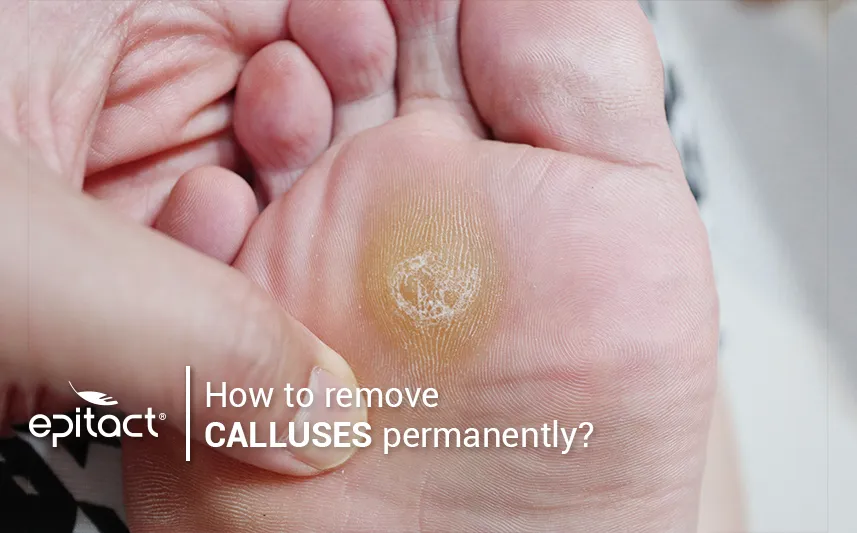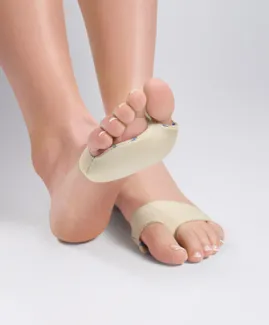
How to remove a plantar callus and to avoid its reappearance? Is podiatric care the only solution to get rid of calluses on feet? How to protect the area before and after the foot callus removal?
Dry feet, inappropriate or worn shoes, foot malformation: the origins of calluses are numerous. Prevention should be systematic, but once the callus is formed, it is important to fight against it... Let’s discover how to remove calluses from feet permanently.
How to get rid of calluses on feet?
Removing a foot callus requires Podiatric care is recommended as a first-line treatment. This is particularly true if your skin is fragile or sensitive (in case of diabetes for example). To get rid of a callus on your foot, simply remove the dead skin and eliminate the factor that has led to the formation of your callus.
Step 1 for plantar callus removal: get rid of the hard and dead skin
To eliminate a foot callus, the podiatrist removes the hard skin and dead skin with special tools. The scalpel and burr are the two most frequent ones. The plantar callus removal is painless and made by appointment.
Step 2 to remove calluses from feet permanently: moisturise your skin
After your podiatrist has removed your plantar callus, he applies a nourishing cream on the skin. This kind of cream moisturises the upper layers of the epidermis by leaving a protective veil on it that preserves from dehydration. Sometimes, the plantar callus removal is so deep that the podiatrist applies a protective dressing.
Foot callus: what is it?
At first, let’s make the difference between calluses and corns; both foot conditions are often confused.
Most of the time, a callus is located in the forefoot, under the sole. It is a thick, hard and large area of skin that may be painful and results from excessive pressures. Its formation can lead to walking disorders. Therefore, treating it as soon as possible becomes essential.
A corn is also a thick and hard area of skin, but it has a witish colour, it is smaller than a callus and usually forms on the toes. It also has a core that penetrates the deep layers of skin, causing even more pain when you walk. Another similarity is that it is also caused by excessive and repeated pressure over a bony protrusion, especially the joints of the toes.
How to avoid recurrence after removal of your foot callus?
You just get rid of your calluses on your feet. Now, you should pay attention to avoid all the factors that have led to their formation so that they do not reappear. Here are a few tips to limit the risk of recurrence after your plantar callus removal.
Choose well-fitting shoes
If you want lasting effect after the removal of your plantar callus, wear shoes that are adapted to your morphology. Avoid narrow shoes that compress your toes and foot, don’t tighten your laces too much and stop wearing high heels. Because they transfer the weight of the body to the forefoot, they increase the pressure under the ball of the foot and so help the development of calluses.
Foot care
At home, you can take foot baths in warm water to soften the skin. Then, use a pumice stone or a foot file and gently sand the hardened area of skin. Don't do this too often because excessive removal of dead skin can have the opposite effect and increase the development of dead skin.
Use protections for your foot
Wearing a thin and comfortable protection relieves pain and strengthens the plantar fat pad to avoid recurrence of hard skin after a foot callus removal. For example, the metatarsal pads* by EPITACT® have been created to daily relieve pain in the forefoot. For more comfort, the 2mm layer of silicone gel distributes pressures, especially while walking. Very pleasant to wear thanks to the ultra-smooth fabric and very easy to wear, these protections are put on like socks!
The best treatment of calluses remains the elimination of their causes. Prevention is key to fight against the reappearance of hard skin on or under the feet. With thin and appropriate silicone protections, you will avoid many ball of foot pain!
To conclude, do not hesitate to consult a specialist who will prescribe you the appropriate treatment and provide you care and advice to get rid of your calluses on your feet permanently. Removal of a plantar callus by a podiatrist is radical but regular moisturising and daily protections will avoid reappearance of hard skin under the foot in the long term.
*This solution is a class I medical device that bears the CE marking under this regulation. Carefully read the instructions before use. Manufacturer: Millet Innovation. 09/2021
 Pharmacie
Pharmacie